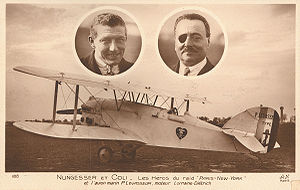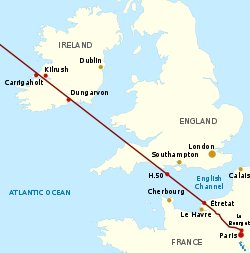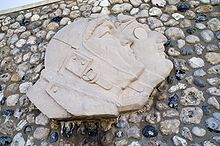- The White Bird
-
For other uses, see White Bird.
The White Bird
(L'Oiseau Blanc)1927 postcard showing The White Bird, with pictures of Nungesser (left) and Coli (right) Role Levasseur PL.8 biplane National origin France Manufacturer Pierre Levasseur Company Designer Levasseur, Nungesser, and Coli Status Lost at sea Primary user Charles Nungesser, François Coli Produced 1927 Number built 1 Developed from PL.4 The White Bird (L'Oiseau Blanc or The White Dove) was a French biplane which disappeared in 1927, during an attempt to make the first non-stop transatlantic flight between Paris and New York. The aircraft was flown by French aviation World War I heroes Charles Nungesser and François Coli, who were attempting to win the USD $25,000 Orteig Prize for the flight, but the plane disappeared after its May 8 takeoff from Paris. Two weeks later, Charles Lindbergh successfully made the New York–Paris journey and claimed the prize, flying The Spirit of St. Louis.
The disappearance of The White Bird is considered one of the great mysteries in the history of aviation.[1] Many rumors circulated about the fate of the plane and crew, with mainstream opinion at the time being that the aircraft was probably lost in a squall over the Atlantic. Investigations starting in the 1980s suggest that the plane probably reached Newfoundland, and may have crashed in Maine.
The White Bird has an extensive legacy, and is referred to in many films and museums. A street in Paris is named after the aviators, and a commemorative postage stamp was issued in 1967. A statue at the Paris Le Bourget airport honors the attempted flight, and there is a memorial on the cliffs of Étretat, from where The White Bird was last seen in France.
Contents
Background
In 1919, New York hotel owner Raymond Orteig offered a USD $25,000 prize, the Orteig Prize, to the first crew to make a non-stop transatlantic flight between New York and Paris during the next five years.[2] With no takers, he renewed the offer in 1924, and aviation technology had advanced enough at that point that many people tried for the prize. Most were attempting to fly from New York to Paris, but The White Bird was a French attempt, to travel from Paris to New York.[3]
François Coli, a World War I veteran from the French Legion of Honor, had been making historic flights across and around the Mediterranean, and had been planning a transatlantic flight since 1923. His original plans were to fly with his wartime comrade Paul Tarascon, a flying ace with 12 victories from the war. They became interested in the Orteig Prize in 1925, but in late 1926 an accident destroyed their Potez 25 biplane. Tarascon was badly burned, and relinquished his place as pilot to Charles Nungesser, another Legion of Honor veteran and highly experienced flying ace with over 40 victories, third highest among the French.[1][4][5]
Construction
Nungesser, age 35, and Coli, 45, participated in the design of a new biplane, a Levasseur PL.8, based on the PL.4 reconnaissance aircraft. Working with Chief Engineer Emile Farret and factory manager Albert Longelot at the Pierre Levasseur Company in Paris, they removed two of the forward cockpits and replaced them with fuel tanks, as well as adding more reinforcement of the fuselage, which was shaped to allow for a water landing. The fuel tanks were enormous, three tanks holding 1,056 gallons (4,025 liters) of gasoline. The main cockpit was widened to allow Nungesser and Coli to sit side by side. The wing span was also increased to approximately 48 ft (15 m). A single Lorraine-Dietrich engine was used, W-12 450 horsepower (340 kW), with the cylinders set in three banks spaced 60° apart from one another, similar to the arrangement used in Napier engines. The engine was tested to ensure it would last the entire flight, and was run for over 40 hours while still in the Parisian factory.[1]
The aircraft was painted white, had the French tricolor markings, and Nungesser's personal WWI flying ace logo: a skull and crossbones, candles, and a coffin, on a black heart.[6] The biplane carried no radio (considered too unreliable to be worth the extra weight), and relied only on celestial navigation, a specialty of François Coli from his previous flights around the Mediterranean. Since Nungesser & Coli's plan was to make a water landing in New York, in front of the Statue of Liberty,[4] the landing gear was designed to be jettisoned on take-off, in order to reduce the plane's weight. As of 2008, the landing gear is the only confirmed part of the plane remaining, and is on display at the French Air and Space museum, the Musée de l'Air et de l'Espace at Le Bourget airport in Paris, the location from which The White Bird took off, and two weeks later, Lindbergh's Spirit of St. Louis landed.[7]
Flight
The White Bird took off at 5:17 a.m. May 8, 1927 from Le Bourget Field in Paris, heading for New York.[6] The biplane weighed 11,000 lb (5,000 kg) on takeoff, extremely heavy for a single-engined plane.[1] The intended flight path was a great circle route, which would have taken them across the English Channel, over the southwestern part of England and Ireland, across the Atlantic to Newfoundland, then south over Nova Scotia, to Boston, and finally to a water landing in New York.[8]
Once in the air, the biplane was escorted to the French coast by five military aircraft, and sighted from the coastal town of Étretat. A Catholic priest reported a sighting over the Irish village of Carrigaholt, and another sighting was made off the coast of Ireland by a British naval officer, who recorded the note in his log.[9]
Crowds of people gathered in New York to witness the historic arrival, with tens of thousands of people crowding Battery Park in Manhattan to have a good view of the Statue of Liberty, where the plane was scheduled to touch down. Rumors circulated that the plane had been sighted along its route, in Newfoundland, or over Long Island.[4] In France, some newspapers even reported that Nungesser & Coli had arrived safely in New York, evoking a wave of French patriotism. But the plane did not arrive on schedule, and after days had gone by with no word from the plane, hope faded. The White Bird had been carrying a sizable load of fuel, 4,000 litres (1,056.7 US gal), which would have given them approximately 42 hours of flight time. After this time had passed, with no word as to the plane's fate, it was realized that the plane had been lost.[10] In France, the public was scandalized by the newspapers such as La Presse which had printed false reports about the plane's arrival, and outrage was generated against the companies involved, with demonstrations in the streets.[3][11]
An international search was launched. Aviation Digest sponsored Floyd Bennett to search the area between New York and Newfoundland for nine days. The Canadian Ministry of Lands and Forests sent out two search planes (one of which crashed). Searchers including the French Navy, the U.S. Navy, and the Canadian Navy scoured the route, including Labrador, the northeast coast of the U.S., and the area around the St. Lawrence River. But there was no sign of The White Bird.[4][9]
Twelve days after Nungesser & Coli's departure, Charles Lindbergh, flying solo, left New York on his own famous journey aboard the Spirit of Saint Louis. After a flight of 33 hours, 30 minutes, he received a hero's welcome when he arrived in Paris, even as the French mourned for the loss of Nungesser and Coli.[7]
Mystery
The mainstream view was that the Bird crashed over the Atlantic due to a squall. But 12 witnesses in Newfoundland and Maine claimed to have heard the aircraft as it passed. If these stories were true, they would have meant that the flight was far behind schedule, as they would have been in the 40th hour of flight. This delay may have been explained, however, by the fact that The White Bird was flying against the prevailing weather pattern. Fishermen off the coast of Newfoundland reported that the weather had turned cold and foul, which might have caused the delay.[6]
Many rumors swirled around the plane's disappearance: Perhaps The White Bird had been shot down by rum-runners with tommy guns; maybe Nungesser and Coli were still alive and living with Indians in Canada. In 1930, claims circulated that the Bird's engine had been located in Maine, but nothing was confirmed.[1] Later stories emerged in 1948, from reports that caribou hunters and fur trappers had found an aircraft wreck in Great Gull Pond.[12]
A fresh round of interest in The White Bird began in the 1980s, after freelance writer Gunnar Hansen of Northeast Harbor, Maine, researched and published an article in the June 1980 issue of Yankee Magazine, titled "The Unfinished Flight of the White Bird".[13] Hansen revealed how Anson Berry (d. 1936), a hermit living near Machias, Maine, claimed to have heard a sputtering aircraft fly over his isolated camp at Round Lake, Maine, late in the afternoon of May 9, 1927.[14] Berry had not been able to see the aircraft because of fog and low clouds, but had heard what sounded like a crash or forced landing in the distance. Hansen and others did a great deal of research during the 1980s, and located multiple other witnesses who reported memories of the aircraft in a line from Nova Scotia down to eastern Maine on that date.[15][16]
In 1984, the French government made an official investigation, concluding that it was possible that the plane had reached Newfoundland.[3][8] In 1989, the NBC television series Unsolved Mysteries advanced the theory that the two aviators made it across the ocean, but crashed and perished in the woods of Maine. One of Nungesser's relatives, William Nungesser, made several trips to Maine to search, focusing his energies around the north slope of Round Lake Hills in Washington County, Maine, as well as the area around Lake Winnipesaukee.[6]
Famed author Clive Cussler and his NUMA organization also attempted to solve the mystery, searching for the plane in Maine and in Newfoundland. They made multiple visits in the 1980s, and interviewed dozens of elderly witnesses: hunters, fishermen and others who said they had seen or heard the plane pass by in 1927. The NUMA expedition was named "Midnight Ghost",[5] after Lindbergh's quote in his book The Spirit of St. Louis, where he said that Nungesser and Coli had "vanished like midnight ghosts".[12][14] In 1992, divers traveled to Newfoundland and attempted to locate and search Great Gull Pond for a wreck, but found nothing, and were not even sure that they had located the right lake.[12][16] Other lakes were also searched, from Machias, Maine, to Chesterfield.[15]
Certain pieces were found which, though not conclusive, did suggest that the Bird made it to the continent. Little of the plane would have remained, since The White Bird was created primarily from plywood and canvas. The parts most likely to endure would have been the engine and the aluminum fuel tanks.[1][6][15] In Maine though, bits and pieces of struts were found, and wood similar to the kind used to build the biplane. Engine metal was also found near the town of Machias, that was not typical to the United States or Canada. Two local residents described a large metal object, a "really big motor" which had been dragged out of the woods for salvage, along a path allegedly made by a logging operation.[6][12]
There is a also report that the Bird may have crashed near Saint Pierre and Miquelon[17]
Currently, an unofficial French team is focusing on theories that the plane crashed off the coast of Canada after flying over Newfoundland.[18]
Legacy
The disappearance of The White Bird has been called "the Everest of aviation mysteries". TIGHAR, The Interest Group for Historic Aircraft Recovery, has called the Bird "History's Most Important Missing Airplane".[1] If the plane had successfully completed its journey, Lindbergh would probably not have made his own historic flight, and might instead have set his sights on crossing the Pacific, which might have prevented Amelia Earhart from attempting her own journey. When Lindbergh did succeed with his own flight across the Atlantic, the international attention on his achievement was probably enhanced because of the disappearance of The White Bird just days earlier. It is also suggested that it was Lindbergh's historic success which gave a major boost to the American aviation industry, without which the course of America's military and industrial accomplishments might have been quite different.[15]
A monument was erected in Étretat in 1927, to mark the last place from which L'Oiseau Blanc was seen in France, but it was destroyed in 1942 by the occupying German army. A new 24 m (79 ft) high monument, the "Monument Nungesser et Coli", was erected in 1963 atop one of the cliffs. There is also a nearby museum.[19][20]
Another monument in France was erected in 1929, at Le Bourget airport. Honoring Lindbergh, Nungesser, and Coli, it is inscribed, "A ceux qui tentèrent et celui qui accomplit" (trans: "To those who tried and one who succeeded"). The French issued a commemorative postage stamp in 1967, forty years after the Bird's departure, to honor Nungesser and Coli's attempt.[21] A street, "Rue Nungesser et Coli" is named after the aviators, along the Stade Jean Bouin in the 16th arrondissement of Paris.
In 1928, the Ontario Surveyor General named a number of lakes in the northwest of the province to honour aviators who had perished during 1927, mainly in attempting oceanic flights.[22][23] Amongst these are Coli Lake (51°19′N 93°35′W / 51.32°N 93.59°W) and Nungesser Lake (51°29′N 93°31′W / 51.49°N 93.52°W).
The fate of The White Bird is occasionally mentioned in films. The 1999 made-for-TV Canadian film Restless Spirits, a children's film with the alternate title Dead Aviators, uses the mystery of The White Bird's disappearance as the key plot device. A young girl, who struggles with her pilot father's death in a plane crash years before, visits her grandmother in Newfoundland. While there, she encounters the ghosts of Nungesser and Coli, whose restless spirits constantly relive their own unheralded 1927 crash in a nearby pond. The girl decides to help the pair move on to the afterlife by assisting them in rebuilding their airplane and completing their flight so they may be released and, by doing so, works through her own emotional distress over her father's test flight death.[24] And in the opening montage of the 2005 film Sahara, based on Cussler's novel, a French newspaper article is displayed reporting a fictional story of NUMA finding the airplane.[25]
See also
References
- ^ a b c d e f g "The Secret of The White Bird". aero-news.net. May 9, 2006. http://www.aero-news.net/news/featurestories.cfm?ContentBlockID=c22b14fc-5c71-4b9b-ac77-a08f5528439f&Dynamic=1. Retrieved January 16, 2009.
- ^ Schneider, Keith (November 12, 2007). "Win fabulous prizes, all in the name of innovation". New York Times.
- ^ a b c Ministry of Transport, Republic of France (June 1984). "Nungesser and Coli disappear aboard l'Oiseau Blanc - May, 1927". tighar.org. http://www.tighar.org/Projects/PMG/FrenchReport.htm. Retrieved January 18, 2009.
- ^ a b c d O'Mara, Richard (January 10, 1999). "Surviving Amelia". The Sun.
- ^ a b "Curtain Call" (pdf). Tighar Tracks (TIGHAR) 3 (1). Spring 1987. http://www.tighar.org/TTracks/1987Vol_3/0301.pdf. Retrieved January 17, 2009.
- ^ a b c d e f Wiggens, Bill (July 1999). "Mystery of the White Bird". Air Classics. http://findarticles.com/p/articles/mi_qa3901/is_199907/ai_n8863766. Retrieved January 16, 2009.[dead link]
- ^ a b Ward, John W. (Spring 1958). "The Meaning of Lindbergh's Flight". American Quarterly (The Johns Hopkins University Press) 10 (1): 3–16. doi:10.2307/2710171. JSTOR 2710171.
- ^ a b Farrell, John Aloysius (March 8, 1987). "Unraveling the mystery of White Bird's flight". Boston Globe.
- ^ a b Clayton, John (May 28, 2006). "The White Bird: Tracking an aviation mystery to NH". New Hampshire Sunday News.
- ^ Mosley, Leonard (2000). Lindbergh: A Biography. Courier Dover Publications. pp. 86. ISBN 0486409643.
- ^ Wohl, Robert (2005). The Spectacle of Flight: Aviation and the Western Imagination, 1920-1950. Yale University Press. pp. 10. ISBN 0300106920.
- ^ a b c d Laskey, Jane (July 10, 2007). "Uncovering ghosts". St. Cloud Times.
- ^ Hansen, Gunnar (June 1980). "The Unfinished Flight of the White Bird". Yankee Magazine. http://www.tighar.org/Projects/PMG/Unfinishedflight.html. Retrieved January 18, 2009.
- ^ a b "Project Midnight Ghost". tighar.org. 2006. http://www.tighar.org/Projects/PMG/PMG.html. Retrieved January 18, 2009.
- ^ a b c d Heins, Catherine (July 29, 1998). "White Bird's trail fading - Many convinced trans-Atlantic flier made it to Maine". Bangor Daily News.
- ^ a b "The White Bird". NUMA. http://www.numa.net/expeditions/white_bird.html. Retrieved January 16, 2009.
- ^ TIGHAR Forum
- ^ "Charles Lindbergh Won the Prize, but Did His Rival Get There First? A Countryman Tries to Unravel the Unsolved Mystery of Charles Nungesser's Last Flight," Wall Street Journal, September 6, 2011
- ^ "Office de Tourisme d'Etretat". etretat.net. http://www.etretat.net/office_de_tourisme_etretat/pages/culturelle_etretat_monuments.php. Retrieved January 16, 2009.
- ^ Schofield, Brian (September 22, 2002). "Hop over: five-day drives just across the Channel - France". Sunday Times.
- ^ "Timbre Nungesser Coli" (in French). phil-ouest.com. http://www.phil-ouest.com/Timbre.php?Nom_timbre=Nungesser_Coli. Retrieved October 8, 2009.
- ^ Ontario Ministry of Natural Resources (2007). "St. Raphael Signature Site Strategy". Toronto, ON. http://www.ontla.on.ca/library/repository/mon/16000/263650.pdf. Retrieved 2011-07-19. p 14.
- ^ "Lost Aviators: New Lakes Named". The West Australian (Perth, WA): p. 13. 16 January 1928. http://nla.gov.au/nla.news-article32084097. Retrieved 2011-07-19.
- ^ Restless Spirits at the Internet Movie Database. Retrieved on January 16, 2009
- ^ Sahara (2005) at the Internet Movie Database. Retrieved on January 16, 2009
External links
- "L'Oiseau Blanc". check-six.com. http://www.check-six.com/lib/Famous_Missing/White_Bird.htm. Retrieved January 16, 2009.
- "Picture of The White Bird's landing gear, at the French air and space museum". mae.org. http://www.mae.org/index.php?id=407. Retrieved January 16, 2009.
- "French flying aces 'beat Charles Lindbergh's record'". telegraph.co.uk. http://www.telegraph.co.uk/news/worldnews/europe/france/8069540/French-flying-aces-beat-Charles-Lindberghs-record.html. Retrieved November 11, 2010.
Categories:- 1927 in aviation
- Biplane aircraft
- Unexplained disappearances
- Unsolved deaths or murders
- History of aviation
- Missing aircraft
Wikimedia Foundation. 2010.






